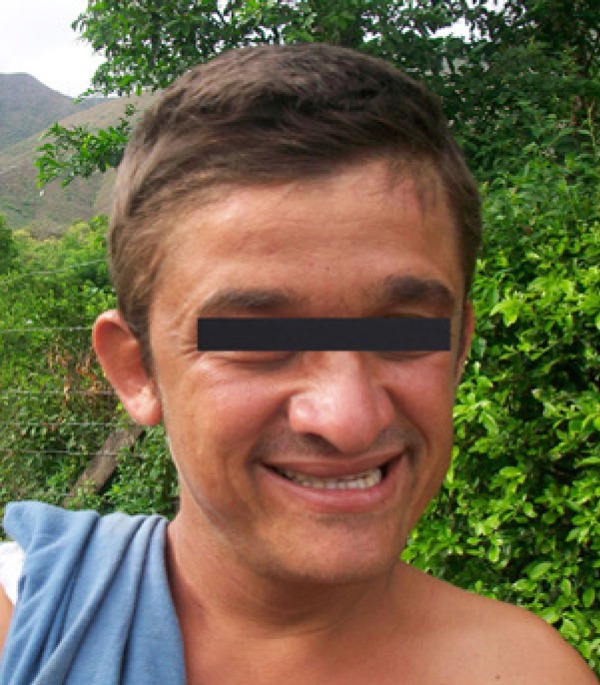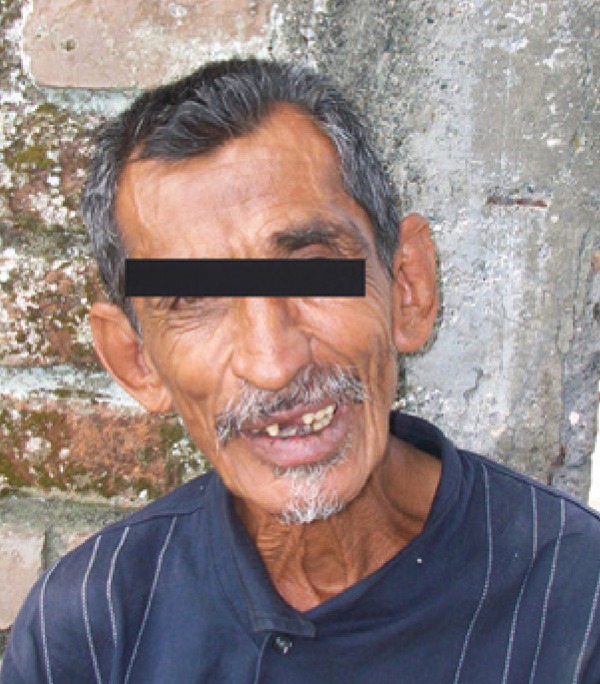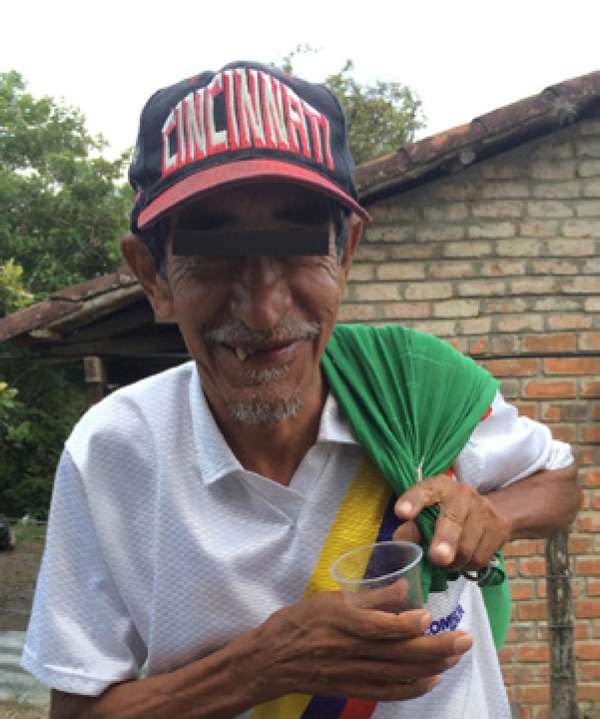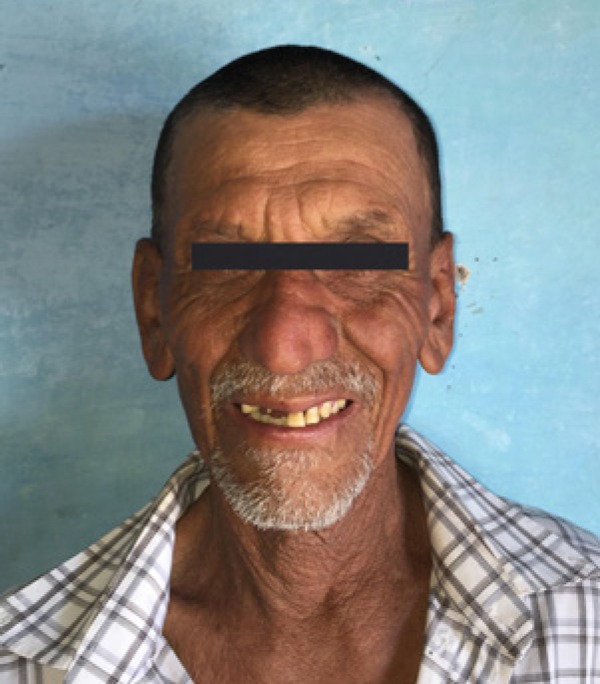Summary
Alcohol use disorders (AUDs) have been reported in a limited number of individuals with cognitive impairment but rarely in those with fragile X syndrome (FXS). However, in Colombia, culturally, alcohol consumption is very common. Here, we report eight cases of patients with FXS who have frequent alcohol consumption in Ricaurte, Colombia. Some of these patients have also used tobacco and illegal substances, including cocaine, which use has not been previously reported in those with FXS. Alcohol and substance use dependence is associated with exacerbation of their behavioral problems, such as increased impulsivity and aggression, as well as of medical problems such as an increased frequency of seizures.
Keywords: Alcohol use disorders, fragile X syndrome
1. Introduction
Fragile X syndrome (FXS) is the most common inherited form of intellectual disability (ID) and the most common single gene cause of Autism Spectrum Disorder (ASD) (1). The prevalence is approximately 1 per 5000 in the general population (2), although in Colombia, South America the prevalence is higher than in other parts of the world (3). A very high prevalence of FXS has been found in a small agricultural rural village, Ricaurte, which is close to Cali and this is thought to relate to a founder effect from the Conquistadores originally from Extremadura region of Spain. In Ricaurte, with a population of just under 1,500 people, there are approximately 20 adults with FXS. There are only two main institutions in Ricaurte, the church and the bar where socialization occurs and the individuals with FXS often go to the bar. Many individuals with FXS also work in the fields where it is the custom to drink alcohol.
Alcoholism has rarely been described in those with FXS in the US and in Europe, although occasional cases have been reported in higher functioning individuals with FXS (4). Those with ID or ASD and FXS usually do not frequent bars and those that take care of individuals with FXS typically do not allow the use of alcohol. However, in Colombia particularly in this village those with FXS usually decide for themselves where to go and the social center of the village is the local bar. The use of alcohol is part of the culture in Colombia and the use of cocaine products is a frequent problem because it is easy to obtain. Thus, although alcoholism has only rarely been reported in individuals with FXS, it is common in Ricaurte, Colombia.
Alcohol use disorders (AUDs) are associated with an approximate 6-fold increase in all-cause mortality and is associated with behavior dysregulation including an increase in aggression (5). In this study, we report eight cases of frequent alcohol consumption, six of them meeting criteria for alcoholic dependence syndrome in adult males with FXS. Three additional individuals with FXS that we encountered have had alcohol consumption problems in the past, however they do not consume at present because of family interventions.
2. Patients and Methods
This study was conducted from January, 2016 to May, 2016. The protocol was reviewed and approved by the Ethical Committee of Universidad del Valle; informed consent was provided by the legal guardian of each of the participants. All 20 FXS patients in Ricaurte had DNA testing for FMR1 mutations as previously described (6). All of them had their medical history gathered and their physical examination performed by a member of the research team. We used the DSM-5 criteria to define the severity of ID on the basis of adaptive functioning and not IQ scores, classifying each patient into mild, moderate, severe or profound ID. By using a clinician-administered version of The Alcohol Use Disorders Identification Test (AUDIT), a screening tool developed by the World Health Organization (WHO) derived from a cross-national data set, we assessed three domains: hazardous alcohol use, dependence symptoms, and harmful alcohol use (7,8). We interviewed a family member that resides in the same house with each of the reported cases, since a self-report version of the AUDIT could not be used due to the patients' intellectual disabilities and lack of reading faculties. We found that 8 out of the 20 FXS in Ricuarte drink alcohol regularly; the data pertinent to substance use is included under each of the cases we report. Following the assessment of the AUDIT we applied the International Classification of Diseases (ICD-10) (WHO) criteria (9) for the alcohol dependence syndrome (ADS) to those scoring 8 or more points in the AUDIT obtaining that 6 of 8 met criteria for alcohol dependence syndrome. See Table 1 for results of the AUDIT.
Table 1. The alcohol use disorders identification test (AUDIT).
| Items | C1 | C2 | C3 | C4 | C5 | C6 | C7 | C8 |
|---|---|---|---|---|---|---|---|---|
| 1. How often do you have a drink containing alcohol? | 3 | 3 | 3 | 3 | 3 | 2 | 2 | 2 |
| (0) Never | ||||||||
| (1) Monthly or less | ||||||||
| (2) 2 to 4 times a month | ||||||||
| (3) 2 to 3 times a week | ||||||||
| (4) 4 or more times a week | ||||||||
| 2. How many drinks containing alcohol do you have on a typical day when you are drinking? | 4 | 4 | 1 | 2 | 4 | 4 | 2 | 1 |
| (0) 1 or 2 | ||||||||
| (1) 3 or 4 | ||||||||
| (2) 5 or 6 | ||||||||
| (3) 7, 8, or 9 | ||||||||
| (4) 10 or more | ||||||||
| 3. How often do you have six or more drinks on one occasion? | 4 | 3 | 1 | 1 | 3 | 3 | 1 | 2 |
| (0) Never | ||||||||
| (1) Less than monthly | ||||||||
| (2) Monthly | ||||||||
| (3) Weekly | ||||||||
| (4) Daily or almost daily | ||||||||
| 4. How often during the last year have you found that you were not able to stop drinking once you had started? | 3 | 3 | 0 | 3 | 3 | 3 | 3 | 0 |
| (0) Never | ||||||||
| (1) Less than monthly | ||||||||
| (2) Monthly | ||||||||
| (3) Weekly | ||||||||
| (4) Daily or almost daily | ||||||||
| 5. How often during the last year have you failed to do what was normally expected from you because of drinking? ** | - | - | - | - | - | - | - | - |
| (0) Never | ||||||||
| (1) Less than monthly | ||||||||
| (2) Monthly | ||||||||
| (3) Weekly | ||||||||
| (4) Daily or almost daily | ||||||||
| 6. How often during the last year have you needed a first drink in the morning to get yourself going after a heavy drinking session? | 0 | 0 | 0 | 0 | 0 | 0 | 0 | 0 |
| (0) Never | ||||||||
| (1) Less than monthly | ||||||||
| (2) Monthly | ||||||||
| (3) Weekly | ||||||||
| (4) Daily or almost daily | ||||||||
| 7. How often during the last year have you had a feeling of guilt or remorse after drinking? | 0 | 0 | 0 | 0 | 0 | 0 | 0 | 0 |
| (0) Never | ||||||||
| (1) Less than monthly | ||||||||
| (2) Monthly | ||||||||
| (3) Weekly | ||||||||
| (4) Daily or almost daily | ||||||||
| 8. How often during the last year have you been unable to remember what happened the night before because you had been drinking? ** | - | - | - | - | - | - | - | - |
| (0) Never | ||||||||
| (1) Less than monthly | ||||||||
| (2) Monthly | ||||||||
| (3) Weekly | ||||||||
| (4) Daily or almost daily | ||||||||
| 9. Have you or someone else been injured as a result of your drinking? | 4 | 4 | 0 | 2 | 0 | 2 | 0 | 2 |
| (0) No | ||||||||
| (2) Yes, but not in the last year | ||||||||
| (4) Yes, during the last year | ||||||||
| 10. Has a relative or friend or a doctor or another health worker been concerned about your drinking or suggested you cut down? | 4 | 4 | 0 | 4 | 0 | 2 | 0 | 0 |
| (0) No | ||||||||
| (2) Yes, but not in the last year | ||||||||
| (4) Yes, during the last year | ||||||||
| Total score | 22/40 | 21/40 | 5/40 | 15/40 | 13/40 | 16/40 | 8/40 | 7/40 |
Questions 5 and 8 could not be answered. Question 5: the cases do not hold a steady job or other responsibilities to be measured by this question. Question 8: the patients were unable to understand the question and it could not be answered by a family member.
Case 1, a 27-year-old Hispanic male with a full mutation of > 200 CGG repeats. He has a long history of significant alcohol, marijuana and bazuco (cocaine paste) abuse, starting approximately ten years ago. Cocaine paste is a crude extract of the coca leaf which contains cocaine sulfate along with coca alkaloids and varying quantities of benzoic acid, kerosene and methanol. It is inexpensive and therefore widely used by low-income populations in Colombia. He has also a medical history of behavioral disorders including severe anxiety, angry outbursts and impulsivity, experiencing repeated aggression episodes. At present he is managed with pipotiazine 100 mg, a long lasting antipsychotic, every two weeks. He has severe intellectual disability and his verbal language is very limited. However, family members report him to also be involved in risky sexual encounters with males and homosexual tendencies. After alcohol and drug use he experiences episodes of uncontrollable rage and turns violent with family members. During his medical evaluation he reports hematochezia as a new symptom. He scored 22/40 on the AUDIT and met criteria for ICD-10 ADS (Table 2).
Table 2. Patients with FXS (> 200 CGG repeats).
 |
Case 1. A 27-year-old male has severe intellectual disability and meets criteria for ICD-10 alcohol dependence syndrome. After alcohol and drug use he experiences increased aggression and impulsivity. |
 |
Case 2. A 40-year-old male with a long history of significant alcohol and tobacco abuse. He has a moderate intellectual disability and meets criteria for ICD-10 alcohol dependence syndrome. He experiences exacerbation of his behavioral problems and medical issues related to alcohol consumption. |
 |
Case 3. A 26-year-old male has a moderate intellectual disability and has never shown aggression or apparent secondary effects associated to drinking. |
 |
Case 4. A 32-year-old male with a history of epilepsy. He has a moderate intellectual disability and meets criteria for ICD-10 alcohol dependence syndrome. He experiences more frequent seizure episodes while under the influence of alcohol and increased aggression. |
 |
Case 5. A 68-year-old male has a severe intellectual disability, meets criteria for autism spectrum disorder and alcohol dependence syndrome. He experiences increased anxiety with alcohol intake. |
 |
Case 6. A 57-year-old male has a moderate intellectual disability and meets criteria for ICD-10 alcohol dependence syndrome. He has had two arm fractures as a result of falling while drinking. |
 |
Case 7. A 67-year-old male has a severe intellectual disability, meets criteria for autism spectrum disorder and alcohol dependence syndrome. |
 |
Case 8. A 47-year-old male has a moderate intellectual disability and a history of epilepsy. Currently seizures occur only with alcohol consumption. He does not meet criteria for alcohol dependence syndrome. |
Case 2, a 40-year-old Hispanic male with a full mutation of > 200 CGG repeats. He has a long history of significant alcohol and tobacco abuse that started when he was 18 years old. He prefers to consume alcohol every other day to drunkenness and smokes two packs of cigarettes daily. He does not report any pathologic or surgical history, however reports to have experienced hematemesis once after an alcohol intake. He has a moderate ID, partially attended first grade only but he holds a fair verbal language skill. He works as a farmer. His family members state he is involved in unprotected sexual encounters with prostitutes associated with alcohol intake; he scored 17/40 on the AUDIT and met criteria for ICD-10 ADS (Table 2).
Case 3, a 26-year-old Hispanic male with a full mutation of > 200 CGG repeats. He experiences impulsivity, anxiety and hyperactivity. At present he takes risperidone 2 mg/day. However, his mother says that he sometimes refuses his medication. He has a moderate ID and good verbal communication skills; when interviewed he reported drinking alcohol two or three times a week. He does not smoke or consume illegal drugs. He has never shown aggression or apparent secondary effects associated to drinking, he scored 5/40 on the AUDIT which did not meet cutoff criteria for ADS of 8/40 (Table 2).
Case 4, a 32-year-old Hispanic male with a full mutation of > 200 CGG repeats. He has a history of seizures from childhood. He currently uses carbamazepine 200 mg/day and valproic acid 1 gram/day. He has a moderate ID and works as a helper in a cattle ranch. He had a long history of heavy alcohol consumption that started during his teenage years and stopped a year ago. His family had to intervene by contacting his friends and acquaintances and requesting them not to provide him with liquor since he experienced more frequent seizure episodes while under the influence of alcohol as well as angry outbursts and aggression. He scored 15/40 on the AUDIT and met criteria for ICD-10 ADS (Table 2).
Case 5, a 68-year-old Hispanic male with a full mutation of > 200 CGG repeats. He has a severe ID, meets criteria for ASD and has functional limitations in effective communication. Medical history does not report any pathology or surgical procedure. Family members describe moderate alcohol consumption, about twice a week. However, they cannot precisely say how many drinks he takes because he drinks the left overs of other people at the bar, and this behavior goes on for as long as the bar stays open during the weekend. He does not experience aggressive behavior with the consumption but he becomes more anxious with alcohol intake. He scored 13/40 on the AUDIT and met criteria for ICD-10 ADS. At the time of the medical examination a heart arrhythmia was found and a mucosal wound that his family says he has had for over a year (Table 2).
Case 6, a 57-year-old Hispanic male with a full mutation of > 200 CGG repeats. He has a moderate ID and meets criteria for ASD. His verbal language has limited sentence structure and is very repetitive. He is not followed by a physician and he has never been hospitalized. His mother describes moderate alcohol intake every weekend. He has had two arm fractures as a result of falling while drinking. During the medical examination he was found to have hypertension. He scored 16/40 on the AUDIT and met criteria for ICD-10 ADS (Table 2).
Case 7, a 67-year-old Hispanic male with a full mutation of > 200 CGG repeats. He has severe ID and meets criteria for ASD. His verbal language has very reduced vocabulary. He lacks family support and does not have any medical records. He works in agriculture. At medical examination a fungal skin infection, compatible with tinea versicolor, was found that covered approximately 50% of his body surface. Using basic language he says he drinks alcohol regularly and his friends confirm his statements. He scored 8/40 on the AUDIT and met criteria for ICD-10 ADS (Table 2).
Case 8, a 47-year old Hispanic male with a full mutation of >200 CGG repeats. He has moderate ID and deficits in the comprehension and verbal communication. He was diagnosed with epilepsy at the age of 17, currently using phenobarbital 3 mg/kg/day; keeping seizures under control, occurring only related to drinking. His medical records report divergent strabismus in his left eye and a cataract surgery performed in his right eye. In addition, he suffered an arm fracture while consuming alcohol two years ago. No symptoms were reported during the medical evaluation. He referred weekly low/moderate alcohol consumption. Scoring 7/40 on the AUDIT, which does not meet criteria for ADS (Table 2).
3. Results and Discussion
In this study, we report that 8 of 20 men with FXS, who were evaluated in Ricaurte, had significant alcohol consumption and 6 of them met criteria for alcohol dependence syndrome. The high rate of alcoholism in men with FXS in Ricaurte Colombia is likely related to several issues. The culture in this region includes the use of alcohol with social gatherings and the main area to gather is the bar in this small village or in the fields where many individuals work. There is a lack of medical care in this region so psychiatric medications are usually not available, whereas alcohol can dull the most common behavioral problem of FXS, specifically anxiety and hyperactivity. However, the consequences of alcohol use can include an increase in aggression which is a problem in approximately 30% of those with FXS and many of these cases have had aggression and falls with alcohol consumption.
Agriculture is the base of the economy in the region and most of the people of Ricaurte work in the fields, including those with intellectual disabilities who can function independently. Farmers have been associated with alcohol abuse in many rural regions of the world including Australia (10), India (11), Africa (12,13), China (14), North America (15) and the same is true in Colombia.
Childhood learning disorders or ID is also seen in fetal alcohol syndrome when the mother consumes alcohol during pregnancy which may have exacerbated some of the ID seen in the cases reported here although we did not obtain this history in the cases above. It is also known that individuals with ADHD tend abuse the use of alcohol and other substances (16) and typically all the cases of FXS have ADHD.
Slayter 2010 (17), reviewed Medicaid healthcare billing claims and concluded that 2.6% of all people with ID had a diagnosable substance abuse disorder. Other estimates using different methodologies vary widely, ranging as high as 26% (18). Individuals with ID who are substance abusers share some traits. They tend to begin drinking alcohol a couple years later than their peers without ID, they are less likely to be Caucasian (17) and they are less likely to seek help for their problem. Additionally, this group is at greater risk of complications from drinking because they tend to be prescribed medications for other conditions, such as seizures, metabolic disorders, and co-occurring mental illness that might negatively interact with alcohol and drugs. No previous reports have reported or reviewed the prevalence of alcoholism in FXS.
Kendler et al. 2016 observed that heritable factors contributed in AUD mortality in early to middle adulthood (5). Also, Wrase et al. 2008 observed alterations of cortical and limbic structures in individuals during the development of alcohol dependence (19); these structures are closely related with emotions and decision making (20,21). Such alterations combined with genetic behavioral factors found in individuals with FXS, such as impulsivity, could contribute to drug dependence (22) as well as the involvement in risk-taking sexual behavior observed in some of the cases we report. In addition, elevated rates of alcohol-associated aggression are found in individuals with AUD (23) and may lead to fatal outcomes. On the other hand, long-term alcohol use together with increasing age, tobacco use, poor nutrition and absent health care are furnishing factors for high alcohol-associated mortality rates in late adulthood (5,24).
In FXS, the silencing of the FMR1 gene results in the absence of FMRP causing the over expression of many post synaptic proteins and upregulation of the mGluR5 pathway which can also predispose to substance abuse (25,26). The lack of inhibition of the glutamatergic signaling, especially the dysfunction of mGluR1 and mGluR5 in the absence of FMRP, has been also related to abnormal dendritic morphology, reduced seizure threshold, excess hippocampal and cerebellar long term depression (LTD) and excess a-amino-3-hydroxy-5-methyl-4-isoxazolepropionic acid (AMPA) receptor internalization found in fmr1 knockout animal model (27). This glutamatergic dysfunction is proposed to be involved in the pathophysiology of FXS. Many of the clinical findings in FXS patients including ID, anxiety, seizures and repetitive behaviors among other characteristics can be secondary to diminished inhibitory control of mGluR (27,28,29). Furthermore, mGluR5 signaling is involved in behavioral actions of ethanol including alcohol-induced withdrawal (AW), sedative effect and impaired motor activity (30).
In this report we describe several cases of FXS who are alcoholic likely because of social factors but also predisposed to alcoholism from intrinsic behavioral and molecular factors. Since alcoholism is associated with many health problems (5) in addition to exacerbating behavioral problems such as aggression and impulsivity leading to self-injury as described here. Then it is critical to treat this problem. Although an alcohol treatment program can be effective (31) and there is an urge to find improved medications to treat alcohol dependence (32) this may not be available in a rural, poor setting such as seen in Ricaurte. Acamprosate, an FDA-approved drug for the maintenance of abstinence from alcohol use in adults is also a targeted treatment for FXS (33). Acamprosate has pleiotropic effects impacting glutamate and GABA neurotransmission (34). Its mGluR5 antagonist effect has been demonstrated in animal models of alcoholism (30,35,36) followed by two pilot clinical trials conducted by Erickson et al. 2011 and 2013 in patients with FXS + ASD finding that 75% of the sample responded to treatment exhibiting improvement in social behavior, hyperactivity and communication skills (33). This medication should be studied further not only in those with FXS but also to treat the alcoholism that can occur in this disorder.
Acknowledgements
This work was supported by NICHD grant HD036071; the MIND Institute Intellectual and Developmental Disabilities Research Center (U54 HD079125); and the National Center for Advancing Translational Sciences, National Institutes of Health, through grant UL1 TR00002 and linked award TL1 TR000133 and Universidad del Valle (grant 1771).
References
- 1. Hagerman R, Hoem G, Hagerman P. Fragile X and autism: Intertwined at the molecular level leading to targeted treatments. Mol Autism. 2010; 1:12. [DOI] [PMC free article] [PubMed] [Google Scholar]
- 2. Tassone F, Iong KP, Tong TH, Lo J, Gane LW, Berry-Kravis E, Nguyen D, Mu LY, Laffin J, Bailey DB, Hagerman RJ. FMR1 CGG allele size and prevalence ascertained through newborn screening in the United States. Genome Med. 2012; 4:100. [DOI] [PMC free article] [PubMed] [Google Scholar]
- 3. Saldarriaga W, Lein P, González Teshima LY, Isaza C, Rosa L, Polyak A, Hagerman R, Girirajan S, Silva M, Tassone F. Phenobarbital use and neurological problems in FMR1 premutation carriers. Neurotoxicology. 2016; 53:141-147. [DOI] [PMC free article] [PubMed] [Google Scholar]
- 4. Loesch DZ, Sherwell S, Kinsella G, Tassone F, Taylor A, Amor D, Sung S, Evans A. Fragile X-associated tremor/ataxia phenotype in a male carrier of unmethylated full mutation in the FMR1 gene. Clin Genet. 2012; 82:88-92. [DOI] [PubMed] [Google Scholar]
- 5. Kendler KS, Ohlsson H, Sundquist J, Sundquist K. Alcohol use disorder and mortality across the lifespan: A longitudinal cohort and co-relative analysis. JAMA Psychiatry. 2016; 73:575-581. [DOI] [PMC free article] [PubMed] [Google Scholar]
- 6. Filipovic-Sadic S, Sah S, Chen L, Krosting J, Sekinger E, Zhang W, Hagerman PJ, Stenzel TT, Hadd AG, Latham GJ, Tassone F. A novel FMR1 PCR method for the routine detection of low abundance expanded alleles and full mutations in fragile X syndrome. Clin Chem. 2010; 56:399-408. [DOI] [PMC free article] [PubMed] [Google Scholar]
- 7. Babor TF, Biddle-Higgins JC, Saunders JB, Monteiro MG. AUDIT: The Alcohol Use Disorders Identification Test: Guidelines for Use in Primary Health Care. Geneva, Switzerland: World Health Organization; 2001. http://www.who.int/iris/handle/10665/67205 (accessed January 23, 2016). [Google Scholar]
- 8. Saunders JB, Aasland OG, Babor TF, de la Fuente JR, Grant M. Development of the Alcohol Use Disorders Screening Test (AUDIT). WHO collaborative project on early detection of persons with harmful alcohol consumption II. Addiction. 1993; 88:791-804. [DOI] [PubMed] [Google Scholar]
- 9. World Health Organization. The ICD-10 Classification of Mental and Behavioral Disorders: Diagnostic criteria for research 1993. http://www.who.int/iris/handle/10665/37108 (accessed January 23, 2016).
- 10. Brumby SA, Kennedy AJ, Mellor D, McCabe MP, Ricciardelli LA, Head A, Mercer-Grant C. The Alcohol Intervention Training Program (AITP): A response to alcohol misuse in the farming community. BMC Public Health. 2011; 11:242. [DOI] [PMC free article] [PubMed] [Google Scholar]
- 11. Shidhaye R, Gangale S, Patel V. Prevalence and treatment coverage for depression: A population-based survey in Vidarbha, India. Soc Psychiatry Psychiatr Epidemiol. 2016. DOI: 10.1007/s00127-016-1220-9. [DOI] [PMC free article] [PubMed] [Google Scholar]
- 12. Chasimpha S, McLean E, Chihana M, Kachiwanda L, Koole O, Tafatatha T, Mvula H, Nyirenda M, Crampin AC, Glynn JR. Patterns and risk factors for deaths from external causes in rural Malawi over 10 years: A prospective population-based study. BMC Public Health. 2015; 15:1036. [DOI] [PMC free article] [PubMed] [Google Scholar]
- 13. Akangbe JA, Asiyanbi AO, Ibraheem AF, Animashaun JO, Sola KE. An assessment of health practices among small-scale farmers in Kwara State, Nigeria. Ann Agric Environ Med. 2015; 22:488-490. [DOI] [PubMed] [Google Scholar]
- 14. Wang L, Wheeler K, Bai L, Stallones L, Dong Y, Ge J, Xiang H. Alcohol consumption and work-related injuries among farmers in Heilongjiang Province, People's Republic of China. Am J Ind Med. 2010; 53:825-835. [DOI] [PubMed] [Google Scholar]
- 15. Hsieh HH, Cheng SC, Sharma A, Sanders RA, Thiessen C. The relation of rural alcoholism to farm economy. Community Ment Health J. 1989; 25:341-347. [DOI] [PubMed] [Google Scholar]
- 16. Rhodes SS, Jasinski DR. Learning disabilities in alcohol-dependent adults: A preliminary study. J Learn Disabil. 1990; 23:551-556. [DOI] [PubMed] [Google Scholar]
- 17. Slayter EM. Demographic and clinical characteristics of people with intellectual disabilities with and without substance abuse disorders in a Medicaid population. Intellect Dev Disabil. 2010; 48:417-431. [DOI] [PubMed] [Google Scholar]
- 18. Strain EC, Buccino DL, Brooner RK, Schmidt CW, Bigelow GE. The triply diagnosed: Patients with major mental illness, cognitive impairment, and substance abuse. J Nerv Ment Dis. 1993; 181:585-587. [DOI] [PubMed] [Google Scholar]
- 19. Wrase J, Makris N, Braus DF, et al. Amygdala Volume Associated With Alcohol Abuse Relapse and Craving. Am J Psychiatry. 2008; 165:1179-1184. [DOI] [PubMed] [Google Scholar]
- 20. Bechara A, Damasio H, Damasio AR, Lee GP. Different contributions of the human amygdala and ventromedial prefrontal cortex to decision-making. J Neurosci. 1999; 19:5473-5481. [DOI] [PMC free article] [PubMed] [Google Scholar]
- 21. Winstanley CA, Theobald DE, Cardinal RN, Robbins TW. Contrasting roles of basolateral amygdala and orbitofrontal cortex in impulsive choice. J Neurosci. 2004; 24:4718-4722. [DOI] [PMC free article] [PubMed] [Google Scholar]
- 22. Makris N, Gasic GP, Seidman LJ, et al. Decreased absolute amygdala volume in cocaine addicts. Neuron. 2004; 44:729-740. [DOI] [PubMed] [Google Scholar]
- 23. Heinz AJ, Beck A, Meyer-Lindenberg A, Sterzer P, Heinz A. Cognitive and neurobiological mechanisms of alcohol-related aggression. Nat Rev Neurosci. 2011; 12:400-413. [DOI] [PubMed] [Google Scholar]
- 24. Heinz A, Beck A, Rapp MA. Alcohol a s an environmental mortality hazard. JAMA Psychiatry. 2016; 73:549-550. [DOI] [PubMed] [Google Scholar]
- 25. Kumaresan V, Yuan M, Yee J, Famous KR, Anderson SM, Schmidt HD, Pierce RC. Metabotropic glutamate receptor 5 (mGluR5) antagonists attenuate cocaine priming- and cue-induced reinstatement of cocaine seeking. Behav Brain Res. 2009; 202:238-244. [DOI] [PMC free article] [PubMed] [Google Scholar]
- 26. Quintero GC. Role of nucleus accumbens glutamatergic plasticity in drug addiction. Neuropsychiatr Dis Treat. 2013; 9:1499-1512. [DOI] [PMC free article] [PubMed] [Google Scholar]
- 27. Bear MF, Huber KM, Warren ST. The mGluR theory of fragile X mental retardation. Trends Neurosci. 2004; 27:370-377. [DOI] [PubMed] [Google Scholar]
- 28. Erickson CA, Mullett JE, McDougle CJ. Brief report: Acamprosate in fragile X syndrome. J Autism Dev Disord. 2010; 40:1412-1416. [DOI] [PubMed] [Google Scholar]
- 29. Saldarriaga W, Tassone F, González-Teshima LY, Forero-Forero JV, Ayala-Zapata S, Hagerman R. Fragile X syndrome. Colomb Med (Cali). 2014; 45:190-198. [PMC free article] [PubMed] [Google Scholar]
- 30. Blednov YA, Harris RA. Metabotropic glutamate receptor 5 (mGluR5) regulation of ethanol sedation, dependence and consumption: Relationship to acamprosate actions. Int J Neuropsychopharmacol. 2008; 11:775-793. [DOI] [PMC free article] [PubMed] [Google Scholar]
- 31. Hagedorn HJ, Brown R, Dawes M, Dieperink E, Myrick DH, Oliva EM, Wagner TH, Wisdom JP, Harris AH. Enhancing access to alcohol use disorder pharmacotherapy and treatment in primary care settings: ADaPT-PC. Implement Sci. 2016; 11:64. [DOI] [PMC free article] [PubMed] [Google Scholar]
- 32. Heilig M, Goldman D, Berrettini W, O'Brien CP. Pharmacogenetic approaches to the treatment of alcohol addiction. Nat Rev Neurosci. 2011; 12:670-684. [DOI] [PMC free article] [PubMed] [Google Scholar]
- 33. Erickson CA, Wink LK, Ray B, Early MC, Stiegelmeyer E, Mathieu-Frasier L, Patrick V, Lahiri DK, McDougle CJ. Impact of acamprosate on behavior and brain-derived neurotrophic factor: An open-label study in youth with fragile X syndrome. Psychopharmacology (Berl). 2013; 228:75-84. [DOI] [PubMed] [Google Scholar]
- 34. Mann K, Kiefer F, Spanagel R, Littleton J. Acamprosate: Recent findings and future research directions. Alcohol Clin Exp Res. 2008; 32:1105-1110. [DOI] [PubMed] [Google Scholar]
- 35. Harris BR, Prendergast MA, Gibson DA, Rogers DT, Blanchard JA, Holley RC, Fu MC, Hart SR, Pedigo NW, Littleton JM. Acamprosate inhibits the binding and neurotoxic effects of trans-ACPD, suggesting a novel site of action at metabotropic glutamate receptors. Alcohol Clin Exp Res. 2002; 26:1779-1793. [DOI] [PubMed] [Google Scholar]
- 36. Gupta T, Syed YM, Revis AA, Miller SA, Martinez M, Cohn KA, Demeyer MR, Patel KY, Brzezinska WJ, Rhodes JS. Acute effects of acamprosate and MPEP on ethanol Drinking-in-the-Dark in male C57BL/6J mice. Alcohol Clin Exp Res. 2008; 32:1992-1998. [DOI] [PubMed] [Google Scholar]


